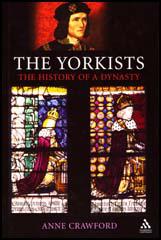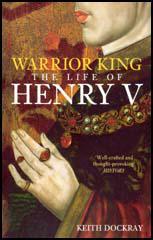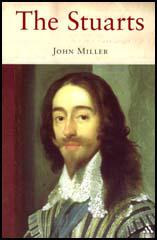Spartacus Review
Volume 2: 8th October, 2007
The British Monarchy

Title: The Yorkists: The History of a Dynasty
Author: Anne Crawford
Editor:
Publisher: Continuum
Price: £19.99
Bookshop: Amazon
Spartacus Website: Richard III
Category:
The Yorkists include both the most wicked king in English history, Richard III, and the most tragic, his nephew Edward V, one of the Princes in the Tower. They had come to the throne in 1461, when Edward IV, who traced his claim to Edward III, replaced the ineffectual Henry VI as king. Forced into exile in 1470, Edward returned to power after the bloody battle of Towton in 1470 finally ended Lancastrian opposition. His reign was ended by his premature death in 1483, leaving behind his son Edward, a minor, as his heir. This led to Richard III's ursurpation, ended two years later by his defeat and death at Bosworth Field at the hands of Henry Tudor, who became Henry VII and the founder of a new dynasty, marrying Elizabeth of York, the daughter of Edward IV. The Yorkists were one of the two main contending parties in England's first great civil war, the Wars of the Roses. They have been immortalised by Shakespeare not only in his Richard III but also in his three parts of Henry VI. Anne Crawford examines the truth behind both the characters of these kings and behind the stories in the plays, including the death of the duke of Clarence by drowning in a butt of malmsey and the celebrated murder of his nephews, Edward V and Richard, duke of York, by their uncle, Richard III.

Title: Warrior King: The Life of Henry V
Author: Keith Dockery
Editor:
Publisher: Tempus
Price: £12.99
Bookshop: Amazon
Spartacus Website: Henry V
Category:
The wild and headstrong prince of William Shakespeare's "Henry IV", blossoms in "Henry V", into a veritable hero-king: an epic embodiment of military valour, serious-minded, and, above all, an archetypal man of action. Such a portrayal reflected not only Shakespeare's Tudor sources but contemporary estimates of "Henry V". For his earliest English biographer, a royal chaplain and well-informed insider, he was a model Christian prince, clearly carrying out God's wishes both at home and abroad; the chronicler Thomas Walsingham, writing soon after the king's death in 1422, judged him a pious, prudent, distinguished and warlike ruler; and, for the humanist Tito Livio in about 1437, he was an energetic, just and shrewd military commander who, at Agincourt, fought 'like an unvanquished lion'. Modern historians have perpetuated the flattery of chroniclers but should they? Was the real Henry V a national hero, a jingoistic bigot, or neither?

Title: The Stuarts
Author: John Miller
Editor:
Publisher: Continuum
Price: £14.99
Bookshop: Amazon
Spartacus Website: The Stuarts
Category:
When James VI of Scotland succeeded Elizabeth as James I on the throne of England in 1603, the Stuarts became the first dynasty to rule Britain as a whole. The problems that James and his successors encountered in reconciling their kingdoms led to tensions and revolts in Scotland, Ireland and England itself, leading to the Civil War under Charles I between 1642 and 1646, and to the king's subsequent execution. While Charles II, restored after Cromwell's Interregnum, died on the throne, his brother James II quickly alienated much of the political nation and had to flee abroad after an invasion by his son-in-law, who became William III. Following William's death, James's daughter Anne presided over a period of victory on the Continent, but bitter internal tension at home. Her death without an heir in 1714 brought in the Hanoverians. In "The Stuarts", John Miller looks at the individual monarchs who made up this remarkable dynasty. He also examines the history of the dynasty as a whole, in terms of the Stuarts' identity and agenda as a ruling house.

Title: The Three Richards
Author: Nigel Saul
Editor:
Publisher: Continuum
Price: £14.99
Bookshop: Amazon
Spartacus Website: Richard II
Category:
The three Richards who ruled England in the middle ages were among the most controversial and celebrated English kings. Richard I (‘Coeur de Lion’, 1189-99) was a great crusading hero; Richard II (1377-99) was an authoritarian aesthete deposed by his cousin, Henry IV, and murdered; while Richard III (1483-85) as the murderer of his nephews, the Princes in the Tower, was the most notorious villain in English history. This highly readable joint biography shows how much the three kings had in common, apart from their names. All were younger sons, not expected to come to the throne; all failed to leave a legitimate heir, causing instability on their deaths; all were cultured and pious; and all died violently. All have attracted accusations but also fascination. In comparing them, Nigel Saul tells three gripping stories and shows what it took to be a medieval king.
